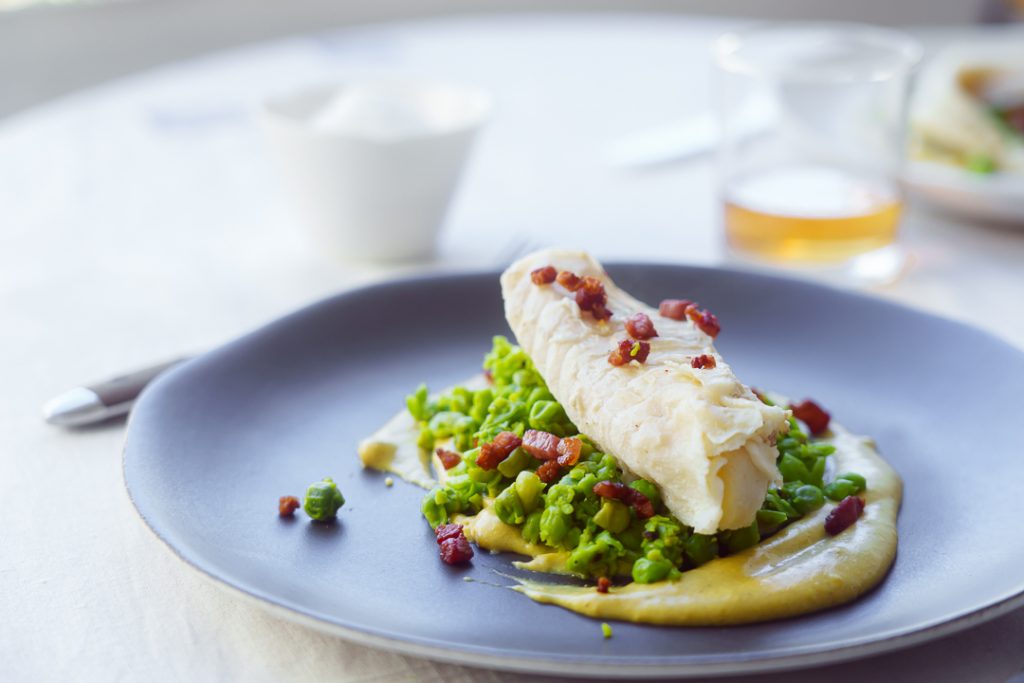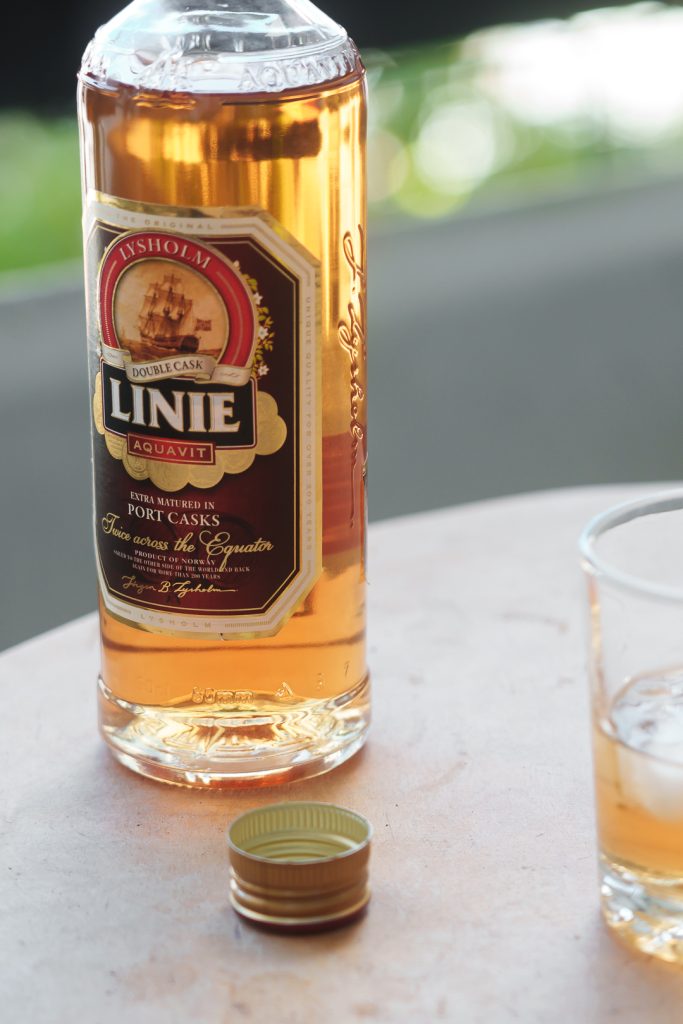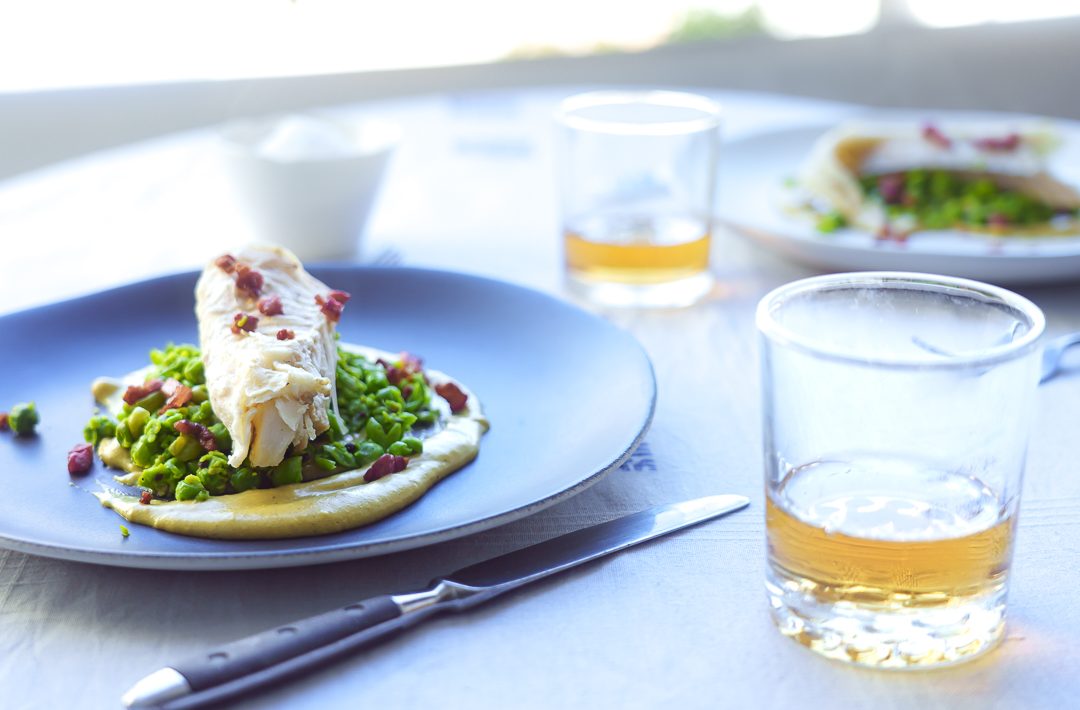A Bacalao Surprise
We parked Nordzy a few hundred meters from the harbor at the top of a steep hill near the center of Bergen. The steepness was an omen of things to come in this land of fjords. Descending slightly from the apex we entered the home of Terje Inderhaugh, one of the group of locals helping to organize our trip. I christened them the 3 amigos. He told us a little about mackerel, which we were there to research, but Terje isn’t a mackerel expert. No, Terje is an afficionado of something from even further norther than we could venture: lutefisk.
Climbing the stairs into the kitchen, the intense aromas of piping hot Bacalao greeted our noses. The acidic tomatoes, sweet peppers, bitter olives, and of course the saltiness of the sea: he had prepared that lavish, bacalao meal for us with his favorite clipfish. Clipfish, Terje explained, is salted and dried cod. Traditionally, Norwegians produce it on the rocks in mid-Norway. This is where it gets its traditional name, Klippfisk, meaning “sea rock fish.” However, today you are more likely not to see this fish as it is produced indoors and not on cliffs any longer. But the use of traditional dry salting and wind tunnels can provide the best quality fish as recognised by slow food.
Upstairs/Downstairs
After breaking bread together to dip into that extravagant stew, we headed down to the cellar. Terje’s home is a traditional Bergen house containing multiple floors and built directly against the rocks that climb straight up from the harbor. From the roof you could walk right out the back and pass by the granite stones that sit as a foundation for the city. In the basement, the same stones form the walls. It was down there that Terje was eager to give us a glimpse into his freezers.
Contained within, he displayed stockfish he had stocked up on. They came from the Lofoten. They’re the best found fish from Sufi company, he informed us. And they had a special purpose: he has going to transform all of them into Lutefisk. Jennifer wrinkled her nose at the sound of the word. I’d heard her mention it before, but I had been too focused on organizing the trip to register the intricacies of stockfish recipes she had been going on about. What’s lutefisk, I asked.
Lutefisk Explained
Lutefisk is a form of stockfish. However, unlike the clipfish in bacalao, lutefisk goes through a longer, saltless drying process. That means that instead of 2 days it takes to reconstitute clipfish stockfish takes 11. But there there’s still one more transformation, the piece de resistance.
Lutefisk steeps for two days in a bath of water and birch ash.
This is where lutefisk gets its name: lute is ‘lye’ in English. Lye, as you may remember, is the main ingredient in soap making. Therefore it does make sense that it provides disinfectant qualities, as many other preservation techniques tend to do. However, normally we don’t wash our food in soap. I’m not going to go too much into the story of Lutefisk today. Instead, I’m going to save that for another post in which we experiment with home produced lutefisk. No, right now we just want to share the recipe that Terje offered us to try his Lutefisk back in Belgium.
A well-travelled Cod
After our first visit to Bergen, we spent the next 3 weeks or so fishing in the fjords nearby. We returned for the Bergen Food Festival. And, yes, eventually we had to go home. But not long after, Joseph received an invitation to Terra Madre in Torino, Italia. It’s the Biannual event of Slow Food International. It features artisan food producers from around the world and detailed seminars and presentations by food activists and experts. Who else should be attending the event to talk about Stockfish? Our good friend, Terje. He had turned all of those stockfish he had shown us into Lutefisk. He even vacuum-sealed about 2 kilos for me to take home.
I never thought I’d be smuggling Norwegian fish from Italy to Belgium.
joseph
But before I took the bag, Terje warned me, It’s going to smell terrible when you open the bag, but don’t worry. Rinse it off in the sink before you boil it. Trust me, this is the best batch of lutefisk I’ve ever made.
With that we said our farewell, for now. On my way up the tarmac stairs to the plane with smelly fish in my carry-on, I remembered Jennifer’s face in that cellar back in Bergen. What were we in for?

It turns out Terje was trustworthy after all. The fish smelled pretty rancid at first sniff. But rinsing and boiling turned disgust into a subtle aroma that recalled a ripe camembert.
On my third bite I called it the Andouillette of the sea.
Joseph
In other words, its taste and perfume contained the best of what good fermentation and preservation has to offer: Earthy notes in rhythm with the texture of the food. We paired it with a bottle of Linie-an aquavit that ages in barrels stored on sailing vessels that circumnavigate the planet A perfect compliment to this truly authentic Norwegian meal. Smakelijk!

Traditional Lutefisk
Ingredients
- 2 slices bacon cut into 5 mm cubes
Mustard sauce
- 2 tbsp butter
- 3 tbsp flour
- 1/2 ts nutmeg
- 1,5 cup milk
- 1 tbsp dijon mustard
- 1 tbsp coarse mustard
- 1 tbsp mustard powder
- pepper and salt
- 1,5 cup fish stock
Pea mash
- 450 gram frozen peas
- 1 tbs butter
- pepper and salt
Lutefisk
- 480 grams Lutefisk Stockfish prepared in a lye solution
- water
- salt
Instructions
- Cook the bacon cubes in pan until they are noice and crunchy. Scoop onto a peper towel and set aside.
Mustard sauce
- Melt the butter in a saucepan. Whisk in the flour and nutmeg until smooth. Stir for 2 minutes. Turn the heat down and gradually add the milk while whisking the mixture to prevent lumps.
- Simmer at low temp for 10 minutes before you season it with the various mustards. Boil it shortly and season to taste with pepper and salt at the end. Stir in salt and pepper.
- Gradually add the fish stock, stirring constantly until thickened. Cover until you are ready to serve.
Pea mash
- Blanch the peas in boiling, salted water until they are just cooked.
- Pour off the water and add back to the pan with a knob of butter. Heat through for 2-3 minutes.
- Mash the peas coarsely with a fork or potato masher and season to taste with pepper and salt.
- Cover and let rest until you ar ready to serve.
Lutefisk
- Rinse the lutefisk well under cold, running water.
- Bring a big pot of salted water to a boil and boil the Lutefisk gently for 5-10 minutes.
- Scoop the Lutefisk out and serve on top of the pea mash with the mustard sauce, crispy bacon and boiled potatoes.





Recent Comments